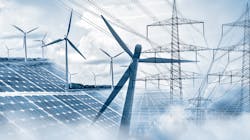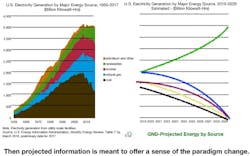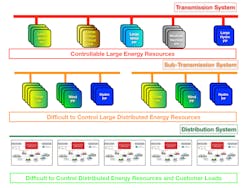A Practical Pathway for Our National Energy Future: Part 4
Reducing carbon output from the American power grid is an essential goal, meriting urgent and committed attention. But there are dangers of a 10-year timeline. Part 1 of this series discusses those dangers and introduces the new grid at the edge. Part 2 offers a way to achieve a low-carbon renewable energy power system. Part 3 describes the transition to DERs, the shift from an old paradigm to a new paradigm. This final part provides an overview of the proposed new paradigm of power delivery — the new grid.
By 2029, the proposed Green New Deal (GND) generation plan intends to replace current nonrenewable energy sources (petroleum, natural gas, coal, and nuclear) entirely with renewable energy. Renewable energy resources would consist solely of renewable distributed energy resources (DERs). To aid in controlling the grid, the renewable energy resources will be supported with battery energy storage systems (BESS) and inverters.
For purposes of simplicity, Fig. 1 assumes that efficiency improvements and energy conservation efforts offset generation increases because of economic growth. Moreover, an increase in the use of electric vehicles (EVs) will impact both energy requirements and the time of day at which those demands are needed. However, EVs include hydrogen vehicles, so the load service for these vehicles is considered part of renewable energy. Consequently, for purposes of simplification, Fig. 1 assumes a continuing and fixed generation requirement of 4171 billion kilowatt-hours.
Fig. 1 below depicts the hypothetical transition from partial fossil/nuclear/renewable to fully renewable energy by 2029. Nuclear power phases out by 2025. Phasing out nuclear power is a complex process. This effort requires intricate decommissioning practices as well as challenging fuel and waste disposal procedures — all of which must comply with the applicable sections of the Code of Federal Regulations. Fig. 1 is a conceptual diagram reflecting the GND and the total transition to renewable energy by 2029.
The loss of this (almost) carbon-free source of nuclear energy creates a large gap to be filled by renewables. The nuclear loss magnifies the challenges of quickly satisfying the renewable energy deficit. Slowing the reduction of nuclear generation would reduce the implementation pressure placed on new grid implementation without significantly deferring carbon reduction. Moreover, given recent advances in nuclear technology, eliminating existing nuclear energy is a concept that deserves more careful evaluation before proceeding.
According to the U.S. Energy Information Administration, as of Dec. 31, 2017, there were about 8652 power plants in the United States that had operational generators with an individual nameplate electricity generation capacity of at least 1 MW. A power plant may have one or more generating units, and some power plants may use more than one type of fuel. The GND proposes replacing all those fossil and nuclear power plants with renewable energy capacity by 2029.
Renewable DERs would be composed of many large and medium-sized solar and wind energy as well as hydro sources, integrating with a huge number of consumer-based smaller solar energy and other independent microgrid resources (industry, commercial, battery, and hydrogen resources). Even with the introduction of storage (hydrogen and batteries), the outputs of DERs are more difficult to manage because of the vagaries of sunshine, wind availability, and wind strength. The new grid system must include distributed energy resource management systems (DERMs) to control and protect the new DERs.
Without a new grid, the absence of large, easily controllable central power plants to balance power flows, coupled with the undependable power output and difficult controllability of many of the DERs, would encumber the NERC's ability to ensure reliability and adequacy of power supply. To satisfy current power regional generation requirements, the number of large DERs would need to exceed the number of large central power stations. These new DERMs would need the ability to control the large matrix of DERs. This controllability is a key operational success factor of the new paradigm.
Protecting system performance from malicious computer interference is another ongoing crucial task. To prevent significant blackouts and system perturbations, all the foregoing tasks must be done successfully under normal and abnormal (for example, weather extremes or malevolent disruptions) circumstances. The enormous changes proposed by the GND in a 10-year timeframe invite power system chaos, not just significant blackouts and system perturbations.
The following diagram is a hypothetical representation of a preliminary GND:
Challenges in realizing objectives of a new grid, why timeline for a 10-year plan is dangerous
1. Replacing the electric energy production of reliable and controllable power plants with electric energy generated from some intermittently available renewable resources is not sufficient. We also need to replace other services those power plants provide. At the top of this list is a service that is known as operating reserves.
2. The above-mentioned service within a region of an interconnection becomes vital when the region loses one or more of its large electric power production resources and/or its tie-lines to neighboring power systems. This service is currently delivered by some standby resources that can quickly produce and/or increase their production of electric power on short notice within the impacted region to mitigate overloading its remaining tie-lines. Inability to maintain dependable standby electric power production resources can lead to interruption of electricity supply to a large number of electric power consumers.
3. Standby electric power production resources are currently provided mostly by the extra band of fossil-fired steam and/or combined cycle power plants as well as gas turbines, hydro dams, and pump storage systems. Some utilities are evaluating the extent to which they should invest in some storage systems like batteries, controllable renewable resources like hydrogen, and others.
4. Penetration of intermittent resources like wind and solar will demand a level of operating reserves that is many times that of the current level.
The new paradigm: Using the new grid
Fig. 3 conceptually depicts a system satisfying the energy paradigm supporting the new grid. The new grid requires replacing the existing energy paradigm with an enormous matrix of dispersed, renewable DERs. Using aggregators, these DERs supply energy to the existing matrix of distributed consumer connections. To accomplish this, existing control and monitoring systems will require extensive redevelopment. This is the new paradigm and it is theoretical in nature.
Providing safe, stable, and economical operation of the new grid requires extensive redevelopment and reimplementation of the associated energy management and load dispatching systems. This requires developing new DERMs.
Global production of CO2 from combustion
Fig. 4 illustrates the limited relative potential impact (15% of the world) of CO2 resulting from the decarbonization of fuel combustion in the United States. The chart compares the shares by country of CO2 emissions because of carbonaceous fuel combustion to decarbonize carbonaceous fuel combustion in the United States. The chart also shows the share by country of CO2 emissions because of fuel combustion.
Conclusion
The energy concepts associated with the GND, as currently proposed, are visionary but impractical and potentially dangerous. Such shortcomings are delineated in this article. It is the intention of this article to mitigate those shortcomings and to describe a new grid that will facilitate the implementation of a safe, stable, and resilient energy grid, which is predominantly based on lower-, zero-, or near zero-carbon energy resources. This article provides a conceptual blueprint of the new grid as well as a primer on generally how a grid works.
The design and engineering supporting the new grid should be flexible enough to be a fundamental pattern or widespread installation of zero- or near zero-carbon energy resources. The purpose of this article is to stir creativity on a worldwide basis. Sharing engineering efforts internationally via engineering societies and other technical organizations could create design patterns that would facilitate standards of engineering, design, procurement, and construction techniques. Such an approach would minimize "reinventing the wheel" and provide a foundation that would leverage the talents and skills of an international organization of scientists, engineers, and technicians.
Technical acknowledgements
The author would like to thank the following colleagues for offering encouragement, comments, and review of this series. Their help was technical and editorial in nature and does not imply their endorsement of the concepts that the author describes. The views and opinions included within the article are those of the author and may not reflect those of the editors or any other person or entity that contributed to this article.
- John Gentile – Director of Cascadia Energy Technologies, LLC
- Daniel Udovic, PhD-EE, PE – CEO of Processor Innovations
- Joseph Sperry, PhD, editing – Co-founder of S4 Consulting
- Dan Madden, PE – CEO of Eco Energy International
- Nasser Jaleeli, PhD-EE, PE – CEO of Priority-based Control Engineering
- Michael Heyeck, PE – Founder, The Grid Group, LLC
- Tim Lowe, PhD – VP of Eco Energy International
- Harry MacCormack, MFA – Board member of Ten Rivers Food Web
- Bernie Gagliano – Independent consultant and information architect
About the Author
Thomas A. McClimans
Thomas A. McClimans, P. E. is a director of Cascadia Energy Technology in Corvallis, Oregon. He has been enjoying a more than 45-year career in power generation (O&M), power plant construction, and computer control systems. Early in his career, McClimans implemented a groundbreaking direct digital control (DDC) system at an 800-MW coal-fired, super-critical generating unit at the Conesville Power Plant. He later became the youngest plant manager at Conesville, which was a 2000-MW generating station with over 600 employees and an annual budget in excess of US$150 million.
Since then, he has held senior level management and engineering positions in both domestic and international markets, working for such firms as American Electric Power (AEP), Black & Veatch International (BVI), NRG and TECO Power Services. Project responsibilities include EPC management, IT project management, O&M management, and generation portfolio management.
His assignments include some of the most challenging electric generating projects in the world. For example, as director of engineering computer applications for the AEP, he directed developing and implementing the computer control system for the AEP transmission grid and also implemented enterprise asset management systems for the AEP's fossil and nuclear generating plants.
Working as general manager for the BVI, he directed a generation optimization project for the 5000-MW Saudi Consolidated Electricity Co. in Jeddah, Saudi Arabia. Also working for the BVI, McClimans successfully directed redesigning and optimizing a waste-to-energy power plant in the United Kingdom and then managed several EPC projects in Thailand. Working as task manager for BVI-USAID, McClimans managed a project to help restore generation in Afghanistan. Working as general manager for NRG and TECO Power Services, he managed a multistate merchant power plant portfolio based on coal-fired boilers and gas-fired CCTs.
McClimans earned a BSc in electrical engineering from Ohio University. He is a registered professional engineer in Ohio and a life member of Institute of Electrical and Electronics Engineers (IEEE).




